
If you are going to surf often, it’s a good idea to purchase your own surfboard. However, there are a lot of choices for surfboards! How do you know which one to choose? Here are some basics you need to know before you rush off to the surf shop.
- Know Your Skill Level
Many of the differences between surfboards have to do with the skill level of the user. A beginner, for example, is going to want to select a longer, high-volume board that is designed to make it easy for you to paddle and catch your first waves.
You wouldn’t buy an expensive sports car for a teenage driver, and you shouldn’t buy a high-end competitive board to learn on. Also, consider how frequently you plan to go out surfing. If you will be out nearly every day, a more challenging board will help you learn; if you surf less frequently, an easier board will make your experience more fun.
- Understand Different Materials
Surfboards come in two main varieties – hardboards (fibreglass) and soft boards (foam). Beginner surfers should probably choose a soft board, as they are safer and harder to damage. A fibreglass hardboard is going to be very easy to ding and or shatter and can hurt when you wipe out.
They’re also much less expensive and can be found for purchase at almost any sporting goods store. However, a hardboard is less buoyant, which makes it more manoeuvrable.

- Pick The Right Length
The length of the board depends on the kind of waves you will be surfing and your skill level. Surfboards come in three main sizes: longboards, funboards, and shortboards. Longboards are any board over 9′, funboards are 7′ – 9′, and shortboards are under 7′, as a general guideline.
Longer boards are easier to paddle and to catch waves with but can be unwieldy and hard to turn. Shortboards are good for high-performance surfing but are very difficult for learners. Funboards are a good, all-around choice that is fun to use in a variety of surf conditions.
- Choose The Correct Volume
The volume of the board is going to affect its buoyancy. A board without enough buoyancy won’t float correctly, which will make it more difficult to catch waves. Too much buoyancy, however, and you will struggle with manoeuvrability. Width, length, and the material will affect the total volume of the board.
- Don’t Be Afraid To Test It Out
A surfboard is an expensive investment and one that, with any luck, you’ll be using a lot. You wouldn’t buy a new car without test driving it, and you shouldn’t buy a surfboard without knowing exactly what you want.
Many surf shops will let you rent boards, which will let you try out a variety of lengths, volumes, and widths. This way, you can determine what kind of board is going to work for you, and what won’t work for you, before you lay out the cash.

- Think About Your Budget
Some people have the funds to buy a new board whenever they want one; others will have to use the first one they buy for years to come. Consider the cost of the board and whether it will need to be replaced as you progress in skill (or, if you are young, as you grow).
Those on a lower budget should try for a more all-around board, but those with more free cash should beware of buying new boards too often and trying to jump difficulty levels too quickly.
In short, you shouldn’t just rush out and buy the first shiny surfboard that catches your eye. You need to pay attention to the size and material of the board, to ensure that you get a board that’s going to be the one you want.
Renting is a good way to find out what you like before shelling out too much money. But once you find the right board for you, you’ll have many enjoyable days of surfing ahead of you.
At Beachin Surf, you can find the best surfboards with our huge range of surfboard designs. For custom pieces or if you want to see the items in person, come and visit our shop at 262 Maine Road, Toukley, NSW. We are happy to show you around and assist you in finding your dream board.
Please call us today on (02) 4396 5159 or send us an inquiry.
